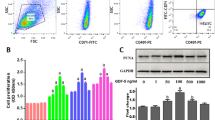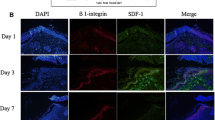Abstract
CD271, a receptor of nerve growth factor (NGF), affects the biological properties of epidermal stem cells (eSCs) which are essential for skin wound closure. Tropomyosin-receptor kinase A (TrkA), another receptor of NGF, combined with CD271 has been involved with nervous system and skin keratinocytes. However, the exact role of TrkA combined with CD271 in eSCs during skin wound closure is still unclear. This study aimed to reveal the role of TrkA in the promoting wounding–healing effect of CD271 on eSCs. We obtained CD271-vo (over-expression of CD271) eSCs by lentiviral infection. K252a was used to inhibit TrkA expression. Full-thickness skin mouse wound closure model (5 mm in diameter) was used to detect the ability of CD271 over-expressed/TrkA-deficient during wound healing. The biological characteristics of eSCs and their proliferation and apoptosis were detected using immunohistochemistry and western blot. The expressions of protein kinase B (pAkt)/Akt, phosphorylated extracellular-signal-related kinase (pERK)/ERK1/2, and c-Jun N-terminal kinase (pJNK)/JNK were also detected by western blot. We found that over-expression of CD271 promoted the biological functions of eSCs. Interestingly, over-expression of CD271 in the absence of TrkA neither promoted eSCs’ migration and proliferation nor promoted wound healing in a mouse model. In addition, we observed the reduced expression of pAkt/Akt and pERK/ERK1/2 following TrkA inhibition in vitro. Our studies demonstrated that the role of TrkA in the promoting wounding–healing effect of CD271 on eSCs.







Similar content being viewed by others
Abbreviations
- Egfr:
-
Epidermal growth receptor
- eSCs:
-
Epidermal stem cells
- GAPDH:
-
Glyceraldehydes-3-phosphate dehydrogenase
- NGF:
-
Nerve growth factor
- PI:
-
Propidium iodide
- TAC:
-
Transit amplifying cells
References
Angeles TS, Yang SX, Steffler C, Dionne CA (1998) Kinetics of trkA tyrosine kinase activity and inhibition by K-252a. Arch Biochem Biophys 349:267–274. https://doi.org/10.1006/abbi.1997.0490
Blanpain C (2010) Stem cells: skin regeneration and repair. Nature 464:686–687. https://doi.org/10.1038/464686a
Boulton TG, Nye SH, Robbins DJ, Ip NY, Radziejewska E, Morgenbesser SD, DePinho RA, Panayotatos N, Cobb MH, Yancopoulos GD (1991) ERKs: a family of protein-serine/threonine kinases that are activated and tyrosine phosphorylated in response to insulin and NGF. Cell 65:663–675
Carter BD, Kaltschmidt C, Kaltschmidt B, Offenhauser N, Bohm-Matthaei R, Baeuerle PA, Barde YA (1996) Selective activation of NF-kappa B by nerve growth factor through the neurotrophin receptor p75. Science 272:542–545
Casaccia-Bonnefil P, Carter BD, Dobrowsky RT, Chao MV (1996) Death of oligodendrocytes mediated by the interaction of nerve growth factor with its receptor p75. Nature 383:716–719. https://doi.org/10.1038/383716a0
Castilho RM, Squarize CH, Gutkind JS (2013) Exploiting PI3K/mTOR signaling to accelerate epithelial wound healing. Oral Dis 19:551–558. https://doi.org/10.1111/odi.12070
Chae CH, Jung SL, An SH, Park BY, Wang SW, Cho IH, Cho JY, Kim HT (2009) Treadmill exercise improves cognitive function and facilitates nerve growth factor signaling by activating mitogen-activated protein kinase/extracellular signal-regulated kinase1/2 in the streptozotocin-induced diabetic rat hippocampus. Neuroscience 164:1665–1673. https://doi.org/10.1016/j.neuroscience.2009.09.075
Chen J, Li Y, Hao H, Li C, Du Y, Hu Y, Li J, Liang Z, Li C, Liu J, Chen L (2015) Mesenchymal stem cell conditioned medium promotes proliferation and migration of alveolar epithelial cells under septic conditions in vitro via the JNK-P38 signaling pathway. Cell Physiol Biochem 37:1830–1846. https://doi.org/10.1159/000438545
Cortazzo MH, Kassis ES, Sproul KA, Schor NF (1996) Nerve growth factor (NGF)-mediated protection of neural crest cells from antimitotic agent-induced apoptosis: the role of the low-affinity NGF receptor. J Neurosci 16:3895–3899
Costantini C, Weindruch R, Della Valle G, Puglielli L (2005) A TrkA-to-p75NTR molecular switch activates amyloid beta-peptide generation during aging. Biochem J 391:59–67. https://doi.org/10.1042/bj20050700
Dai W, Bai Y, Hebda L, Zhong X, Liu J, Kao J, Duan C (2014) Calcium deficiency-induced and TRP channel-regulated IGF1R-PI3K-Akt signaling regulates abnormal epithelial cell proliferation. Cell Death Differ 21:568–581. https://doi.org/10.1038/cdd.2013.177
Dedoni S, Olianas MC, Ingianni A, Onali P (2014) Type I interferons up-regulate the expression and signalling of p75 NTR/TrkA receptor complex in differentiated human SH-SY5Y neuroblastoma cells. Neuropharmacology 79:321–334. https://doi.org/10.1016/j.neuropharm.2013.12.002
Dou YC, Hagstromer L, Emtestam L, Johansson O (2006) Increased nerve growth factor and its receptors in atopic dermatitis: an immunohistochemical study. Arch Dermatol Res 298:31–37. https://doi.org/10.1007/s00403-006-0657-1
Dreger T, Watson JT, Akers W, Molligan J, Achilefu S, Schon LC, Zhang Z (2014) Intravenous application of CD271-selected mesenchymal stem cells during fracture healing. J Orthop Trauma 28(Suppl 1):S15–S19. https://doi.org/10.1097/bot.0000000000000063
Friedman WJ (2000) Neurotrophins induce death of hippocampal neurons via the p75 receptor. J Neurosci 20:6340–6346
Fujimura M, Usuki F (2015) Methylmercury causes neuronal cell death through the suppression of the TrkA pathway: in vitro and in vivo effects of TrkA pathway activators. Toxicol Appl Pharmacol 282:259–266. https://doi.org/10.1016/j.taap.2014.12.008
Ingraham CA, Schor NF (2009) Necdin and TrkA contribute to modulation by p75NTR of resistance to oxidant stress. Exp Cell Res 315:3532–3542. https://doi.org/10.1016/j.yexcr.2009.10.001
Iwata Y, Hasebe Y, Hasegawa S, Nakata S, Yagami A, Matsunaga K, Sugiura K, Akamatsu H (2017) Dermal CD271+ cells are closely associated with regeneration of the dermis in the wound healing process. Acta Derm Venereol 97:593–600. https://doi.org/10.2340/00015555-2624
Johansson O, Liang Y, Emtestam L (2002) Increased nerve growth factor- and tyrosine kinase A-like immunoreactivities in prurigo nodularis skin—an exploration of the cause of neurohyperplasia. Arch Dermatol Res 293:614–619. https://doi.org/10.1007/s00403-001-0285-8
Jones PH, Simons BD, Watt FM (2007) Sic transit gloria: farewell to the epidermal transit amplifying cell? Cell Stem Cell 1:371–381. https://doi.org/10.1016/j.stem.2007.09.014
Kanaji N, Nelson A, Wang X, Sato T, Nakanishi M, Gunji Y, Basma H, Michalski J, Farid M, Rennard SI, Liu X (2013) Differential roles of JNK, ERK1/2, and p38 mitogen-activated protein kinases on endothelial cell tissue repair functions in response to tumor necrosis factor-alpha. J Vasc Res 50:145–156. https://doi.org/10.1159/000345525
Kashiwai K, Kajiya M, Matsuda S, Ouhara K, Takeda K, Takata T, Kitagawa M, Fujita T, Shiba H, Kurihara H (2016) Distinction between cell proliferation and apoptosis signals regulated by brain-derived neurotrophic factor in human periodontal ligament cells and gingival epithelial cells. J Cell Biochem 117:1543–1555. https://doi.org/10.1002/jcb.25446
Khwaja FS, Quann EJ, Pattabiraman N, Wynne S, Djakiew D (2008) Carprofen induction of p75NTR-dependent apoptosis via the p38 mitogen-activated protein kinase pathway in prostate cancer cells. Mol Cancer Ther 7:3539–3545. https://doi.org/10.1158/1535-7163.mct-08-0512
Knusel B, Hefti F (1992) K-252 compounds: modulators of neurotrophin signal transduction. J Neurochem 59:1987–1996
Kumar V, Gupta AK, Shukla RK, Tripathi VK, Jahan S, Pandey A, Srivastava A, Agrawal M, Yadav S, Khanna VK, Pant AB (2015) Molecular mechanism of switching of TrkA/p75(NTR) signaling in monocrotophos induced neurotoxicity. Sci Rep 5:14038. https://doi.org/10.1038/srep14038
Lad SP, Peterson DA, Bradshaw RA, Neet KE (2003) Individual and combined effects of TrkA and p75NTR nerve growth factor receptors. A role for the high affinity receptor site. J Biol Chem 278:24808–24817. https://doi.org/10.1074/jbc.M212270200
Latifi-Pupovci H, Kuci Z, Wehner S, Bonig H, Lieberz R, Klingebiel T, Bader P, Kuci S (2015) In vitro migration and proliferation (“wound healing”) potential of mesenchymal stromal cells generated from human CD271(+) bone marrow mononuclear cells. J Transl Med 13:315. https://doi.org/10.1186/s12967-015-0676-9
Liao TY, Tzeng WY, Wu HH, Cherng CG, Wang CY, Hu SS, Yu L (2016) Rottlerin impairs the formation and maintenance of psychostimulant-supported memory. Psychopharmacology 233:1455–1465. https://doi.org/10.1007/s00213-016-4251-8
Liu M, Chen F, Sha L, Wang S, Tao L, Yao L, He M, Yao Z, Liu H, Zhu Z, Zhang Z, Zheng Z, Sha X, Wei M (2014) (−)-Epigallocatechin-3-gallate ameliorates learning and memory deficits by adjusting the balance of TrkA/p75NTR signaling in APP/PS1 transgenic mice. Mol Neurobiol 49:1350–1363. https://doi.org/10.1007/s12035-013-8608-2
Liu PY, Bondesson L, Lontz W, Johansson O (1996) The occurrence of cutaneous nerve endings and neuropeptides in vitiligo vulgaris: a case-control study. Arch Dermatol Res 288:670–675
Mahadeo D, Kaplan L, Chao MV, Hempstead BL (1994) High affinity nerve growth factor binding displays a faster rate of association than p140trk binding. Implications for multi-subunit polypeptide receptors. J Biol Chem 269:6884–6891
Majdan M, Walsh GS, Aloyz R, Miller FD (2001) TrkA mediates developmental sympathetic neuron survival in vivo by silencing an ongoing p75NTR-mediated death signal. J Cell Biol 155:1275–1285. https://doi.org/10.1083/jcb.200110017
Matsubayashi Y, Ebisuya M, Honjoh S, Nishida E (2004) ERK activation propagates in epithelial cell sheets and regulates their migration during wound healing. Curr Biol 14:731–735. https://doi.org/10.1016/j.cub.2004.03.060
Nykjaer A, Willnow TE, Petersen CM (2005) p75NTR—live or let die. Curr Opin Neurobiol 15:49–57. https://doi.org/10.1016/j.conb.2005.01.004
Salehi AH, Xanthoudakis S, Barker PA (2002) NRAGE, a p75 neurotrophin receptor-interacting protein, induces caspase activation and cell death through a JNK-dependent mitochondrial pathway. J Biol Chem 277:48043–48050. https://doi.org/10.1074/jbc.M205324200
Saltiel AR, Kahn CR (2001) Insulin signalling and the regulation of glucose and lipid metabolism. Nature 414:799–806. https://doi.org/10.1038/414799a
Sarkar A, Tatlidede S, Scherer SS, Orgill DP, Berthiaume F (2011) Combination of stromal cell-derived factor-1 and collagen-glycosaminoglycan scaffold delays contraction and accelerates reepithelialization of dermal wounds in wild-type mice. Wound Repair Regen 19:71–79. https://doi.org/10.1111/j.1524-475X.2010.00646.x
Segrelles C, Garcia-Escudero R, Garin MI, Aranda JF, Hernandez P, Ariza JM, Santos M, Paramio JM, Lorz C (2014) Akt signaling leads to stem cell activation and promotes tumor development in epidermis. Stem Cells 32:1917–1928. https://doi.org/10.1002/stem.1669
Tapley P, Lamballe F, Barbacid M (1992) K252a is a selective inhibitor of the tyrosine protein kinase activity of the trk family of oncogenes and neurotrophin receptors. Oncogene 7:371–381
Truzzi F, Marconi A, Atzei P, Panza MC, Lotti R, Dallaglio K, Tiberio R, Palazzo E, Vaschieri C, Pincelli C (2011) p75 neurotrophin receptor mediates apoptosis in transit-amplifying cells and its overexpression restores cell death in psoriatic keratinocytes. Cell Death Differ 18:948–958. https://doi.org/10.1038/cdd.2010.162
Truzzi F, Saltari A, Palazzo E, Lotti R, Petrachi T, Dallaglio K, Gemelli C, Grisendi G, Dominici M, Pincelli C, Marconi A (2015) CD271 mediates stem cells to early progeny transition in human epidermis. J Invest Dermatol 135:786–795. https://doi.org/10.1038/jid.2014.454
Wang T, Takikawa Y, Watanabe A, Kakisaka K, Oikawa K, Miyamoto Y, Suzuki K (2014) Proliferation of mouse liver stem/progenitor cells induced by plasma from patients with acute liver failure is modulated by P2Y2 receptor-mediated JNK activation. J Gastroenterol 49:1557–1566. https://doi.org/10.1007/s00535-013-0927-6
Yan C, Liang Y, Nylander KD, Wong J, Rudavsky RM, Saragovi HU, Schor NF (2002) p75-nerve growth factor as an antiapoptotic complex: independence versus cooperativity in protection from enediyne chemotherapeutic agents. Mol Pharmacol 61:710–719
Yang SL, Han R, Liu Y, Hu LY, Li XL, Zhu LY (2014) Negative pressure wound therapy is associated with up-regulation of bFGF and ERK1/2 in human diabetic foot wounds. Wound Repair Regen 22:548–554. https://doi.org/10.1111/wrr.12195
Zhang M, Sun L, Wang X, Chen S, Kong Y, Liu N, Chen Y, Jia Q, Zhang L, Zhang L (2014) Activin B promotes BMSC-mediated cutaneous wound healing by regulating cell migration via the JNK-ERK signaling pathway. Cell Transplant 23:1061–1073. https://doi.org/10.3727/096368913x666999
Zhang M, Cao Y, Li X, Hu L, Taieb SK, Zhu X, Zhang J, Feng Y, Zhao R, Wang M, Xue W, Yang Z, Wang Y (2018) Cd271 mediates proliferation and differentiation of epidermal stem cells to support cutaneous burn wound healing. Cell Tissue Res 371:273–282. https://doi.org/10.1007/s00441-017-2723-8
Zuk PA, Zhu M, Mizuno H, Huang J, Futrell JW, Katz AJ, Benhaim P, Lorenz HP, Hedrick MH (2001) Multilineage cells from human adipose tissue: implications for cell-based therapies. Tissue Eng 7:211–228. https://doi.org/10.1089/107632701300062859
Acknowledgements
Yibing Wang and Xiaohong Li conceived and designed the experiments; Min Zhang performed the experiments; Yuehou Zhang and Jiaxu Ma contributed reagents, materials, and analysis tools; Jun Ding, Siyuan Yin and Yongqian Cao analyzed the data; Xiaohong Li and Min Zhang wrote the paper; Xiaohong Li, Faming Tian, Yuan Li, and Jun Ding review the paper and references.
Funding
This study was funded by the National Natural Science Foundation of China (No. 81571911 and 81772092), and Science and Technology Development Program of Shandong Province (No. 2016GSF201080).
Author information
Authors and Affiliations
Corresponding authors
Ethics declarations
Conflict of interest
The authors declared that no conflict of interests.
Ethical approval
All involved animals were performed according to the National Institutes of Health (NIH) Guide. Under pentobarbital sodium anesthesia, all surgeries were performed. Followed by the Committee on the Ethics of Shandong University, the experiments were approved.
Electronic supplementary material
Below is the link to the electronic supplementary material.
Rights and permissions
About this article
Cite this article
Zhang, M., Zhang, Y., Ding, J. et al. The role of TrkA in the promoting wounding–healing effect of CD271 on epidermal stem cells. Arch Dermatol Res 310, 737–750 (2018). https://doi.org/10.1007/s00403-018-1863-3
Received:
Revised:
Accepted:
Published:
Issue Date:
DOI: https://doi.org/10.1007/s00403-018-1863-3




